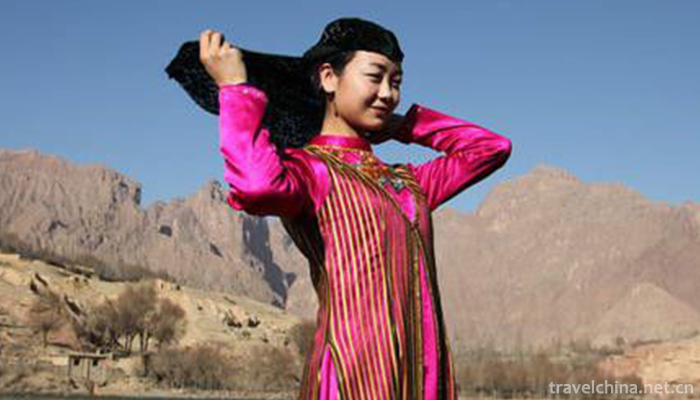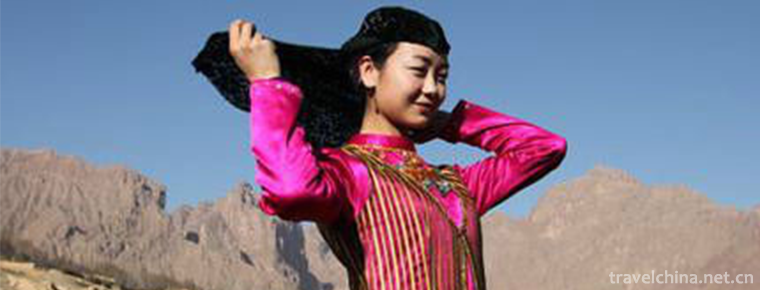Salar Costume
Salar Costume
The traditional dresses of the Salar nationality are bright and bright in color and full of national characteristics. Salar costumes have two characteristics, namely (1) Islamic color of costumes; (2) interaction and harmony with Hui, Tibetan and Han costumes. However, the dresses of the Salar people are generally the same as those of the Hui people. The difference is that their jackets are generally broad and their waists are tied with cloth.
On June 14, 2008, Salar costumes were approved by the State Council to be included in the second batch of national intangible cultural heritage lists.
Costume Style
Salar men usually wear white shirts, black shoulders, belts, trousers, Lotties or cloth shoes, and black or white dome caps. The belts are mostly red and green, while the trousers are mostly black and blue. In winter, men wear sheepskin jackets or woolen brown sweaters, while the wealthy hang cloth or wool outside. Women's jackets, black or purple shoulders, pants, embroidered shoes. Like to wear gold, silver rings, jade, copper or silver bracelets, silver earrings and other jewelry. Young women wear green caps, middle-aged women wear black, and older women wear white.
According to the differences of times and environment, different economic lifestyles and even different climatic characteristics, Salar people create unique national costumes. The earliest clothes were worn in the style of the nomadic people in Central Asia. Men generally wore curly-rimmed lamb caps, half-waist boots, wooden clips (similar to the Uygur "dragonfly"), and red shuttle cloth at the waist.
Women wear the same clothes as men, but only red and blue silk scarves. Later, men usually wear broad jackets or long shirts, trousers, waistbands, wealthy people wear silk ribbons, black or white six-toothed caps, and flat-soled cloth shoes. Older people often wear long gowns and wore "Darsdale" (turban) around their heads at church.
Young men like to wear white pairs of jackets, red cloth belts or embroidered belts around the waist, a suitable black short shoulder jacket, black and white contrast is clear, clean and elegant. When getting married, the waistband is sewn with red and blue satin and embroidered with various flower patterns, Embroidered Ribbon "embroidered girth", and the feet are wearing embroidered socks and cloth slippers.
Middle-aged women's clothes are longer, trousers feet touch the ground generally, feet wear embroidered pointed "Gugu shoes". Young women like to wear bright-coloured large-skinned clothes. Black and green jackets with long or short shoulders are slim and handsome. They like to wear gold and silver earrings, rings and bracelets.
At the end of Ming Dynasty and the beginning of Qing Dynasty, when women went out to work, they wrapped their heads in blue cloth and wore spacious embroidered lace capes on festivals. Later, he changed to wear a "hood" and put it on the back like a windbag. "Cover" is exquisite, the color varies with age. Generally, girls and newly married women are green, which symbolizes vigor and prosperity; middle-aged or married children wear black, which symbolizes maturity, sophistication and dignity; older people are mostly white, which symbolizes white, flawless and natural simplicity.
Regional characteristics
Yunnan and Guizhou. Sala people mainly live in Xunhua, Hualong County of Qinghai Province and Dahejia area of Jishishan Mountain of Gansu Province. Their habitat is relatively concentrated, so their clothes are relatively uniform. In terms of color, men mainly use white and black to avoid red, yellow and colorful clothes; in addition to attending religious ceremonies, women wear colorful clothes and pants, and then wear black or purple shoulders, which are charming and charming. Sala's dress is basically the same as Hui's. The difference is that the jacket is generally broad and the waist is tied with cloth. Salar men like to grow beards, wear hexagonal black or white round caps, young people wear white pair-skinned jacket, black shoulder jacket, black hat, blue trousers. Women wear caps, colorful large-skinned clothes, black shoulders, earrings, bracelets, rings and other gold and silver jewelry. The girl wears a hood after marriage.
historical origin
The Salar people, who believe in Islam, are named for their self-proclaimed "Salar" or "Sala" for short. Some people believe that the Sala people are descendants of the ancient Sarul of the Ugus tribe of the Western Turks. They lived in China in the Tang Dynasty and moved westward to Central Asia. The Yuan Dynasty took Samarkand and returned to China eastward. Up to now, it has been settled in Xunhua area of Qinghai for about 700 years. In the course of long-term historical evolution in the future, due to the natural conditions of the Qinghai-Tibet Plateau, the social and economic conditions of the ethnic group and the interaction with the surrounding brothers, as well as the influence of Islam and other factors, gradually formed their own unique national habits and customs.
Current Situation of Folklore
In the past, men wore embroidered bellies; women wore right jackets, jackets, shoulders, trousers, caps, bright colors, and some used silk as fabrics. In addition, women paid attention to piercing blue patterns between the forehead and the back of their hands. Men and women's jackets are longer than shoulders, wearing to the edge of the outerwear is beautiful. In addition, in the past, Salars wore leather jackets in winter and long shirts in summer, with long and wide sleeves, making it easier to bargain in sleeves. With the development of economic life, the dress of Salars gradually changed to uniform or suit. Even if someone wears a traditional leather jacket, the sleeves are not too wide. So today, many Salars have changed their prices under sheepskin jackets. Those who specialize in the sale of sheepskin cover the sheepskin on their hands, that is, trade.
In the past, the Salar working people mostly wore cloth-free sheepskin jackets or wool-woven "browns" and cloth shoes or cowhide crepe "Loti". Nowadays, with the improvement of people's lives and the prosperity of the market, more changes have taken place in men's and women's clothes. Women wear colorful chemical fibers, silks and satins and wool fashions, with a good quality of Qiaoqi veil cap on their heads, while men wear woolen Zhongshan suits and suits, and new leather shoes on their feet.


-
1.World Dinosaur Valley
Lufeng World Dinosaur Valley is located 23 kilometers south of Lufeng County, Chuxiong Prefecture, at Ana Village Dinosaur Mountain, Chuanjie Township. It is situated beside Kunchu Expressway
Time 2018-12-19 -
2.Holiday Beach
Holiday beach is located on the west coastal avenue of Haikou City, which is 6 kilometers long. On the left side is the verdant forest belt of ephedra, with resorts, hotels, playgrounds and so on
Time 2018-12-23 -
3.Guangxi Medicinal Herb Garden
Guangxi Medicinal Botanical Garden is located in Xiangzhu Avenue, Nanning City, Guangxi Zhuang Autonomous Region. It was founded in 1959 and covers an area of 202 hectares
Time 2019-01-13 -
4.Northeast drum
Northeast drum was once prevalent in Shenyang, and Shenyang set up the Tianfu in the late Qing Dynasty. So it was called "Fengtian drum" in the eighteenth year of the Republic of China (1929
Time 2019-04-27 -
5.Nanjing White Bureau
Nanjing Baiju is an ancient type of music in Nanjing area. The "Nanjing tune" in the Yuanqu brand is the original tune of Baiju's ancient tune. It has a history of more than 700 years. It wa
Time 2019-06-07 -
6.Pulangorgozi
Pulangorgozi, also known as "fruit harmony", is a kind of self-entertaining dance, which originates from Pulan County and is widely spread in Ali countryside. It is a kind of hand in hand, s
Time 2019-06-09 -
7.Qingxu Caimen Building
Qingxu Caimen Tower is a local traditional handicraft in Qingxu County, Shanxi Province. Xu Caimen Tower in Qing Dynasty is said to have originated in Tang Dynasty. During the festival, people gathere
Time 2019-06-11 -
8.Tiger Sheng of Yi Nationality
Tiger Sheng of Yi nationality is a magical traditional dance of Yi nationality. The Yi people worship tigers and take tigers as totems. It has been said since ancient times that tigers are the people
Time 2019-07-12 -
9.Youyang Folk Songs
Youyang folk song is a rich and colorful folk culture created and accumulated by the Tujia, Miao and Han people in Youyang Tujia and Miao Autonomous County of Chongqing in the long practice of product
Time 2019-07-14 -
10.Chongzhou Confucian Temple
One of the four best preserved Confucian temples in Sichuan Province. National key cultural relics protection units. Confucius Cultural Center in Western China. It is located in the south of Chongzhou painting pool.
Time 2020-11-05 -
11.Tianshi cave
Tianshi cave, also known as Chang Taoist temple, is the most important Taoist temple in Qingcheng Mountain. In 1983, it was designated as the national key Taoist temple by the State Council. In addition, there are four palaces in Qingcheng Mountain: Jianfu palace, Yuanming palace, Yuqing palace and Shangqing palace.
Time 2020-11-08 -
12.Kangding yak meat
There are many wild medicines such as Fritillaria, Cordyceps and so on growing in these areas over 3500 meters. Yaks often eat these herbs, and their meat is incomparably delicious. After being killed, they can be roasted in brown sauce, stewed or dried in the cold
Time 2020-12-06